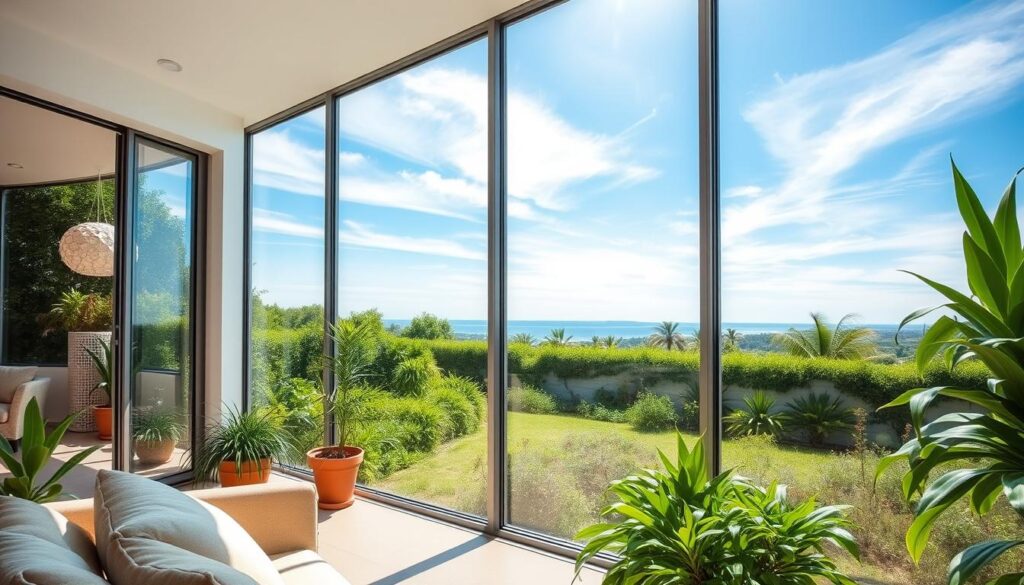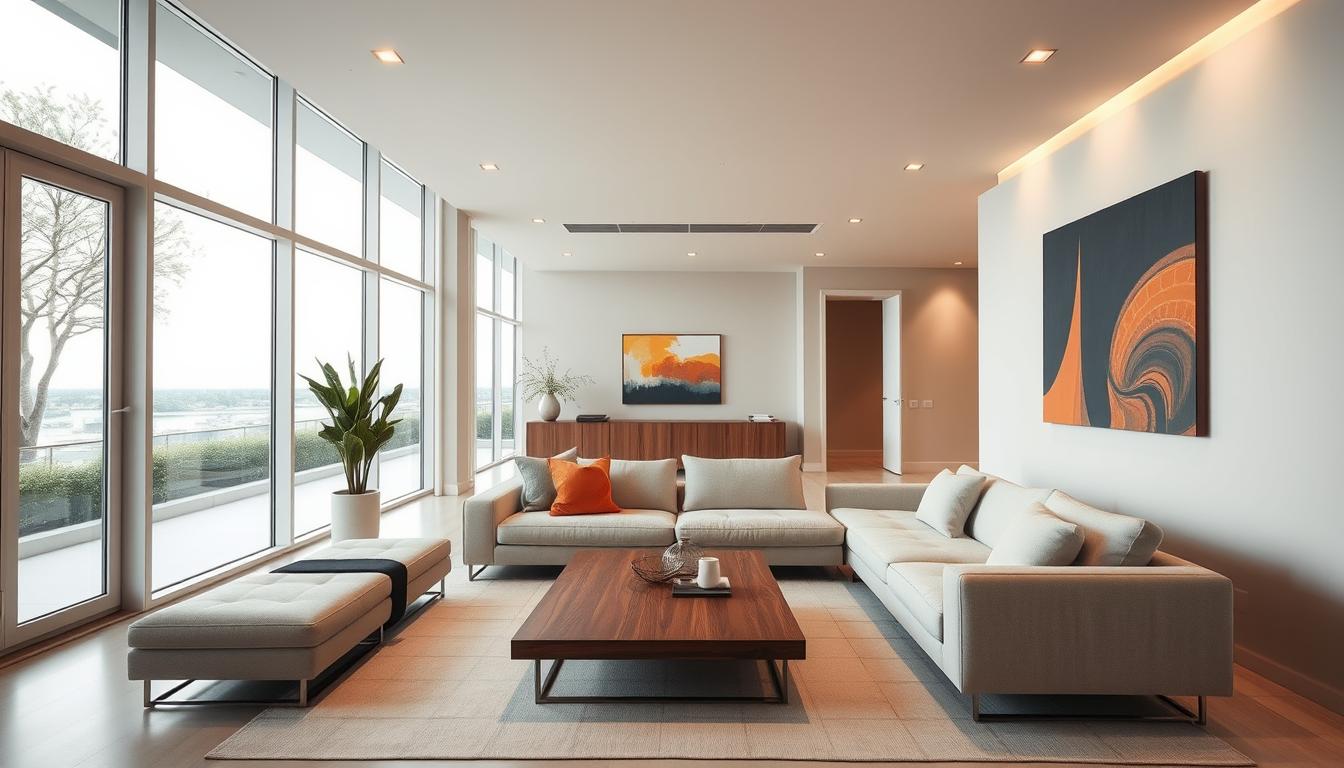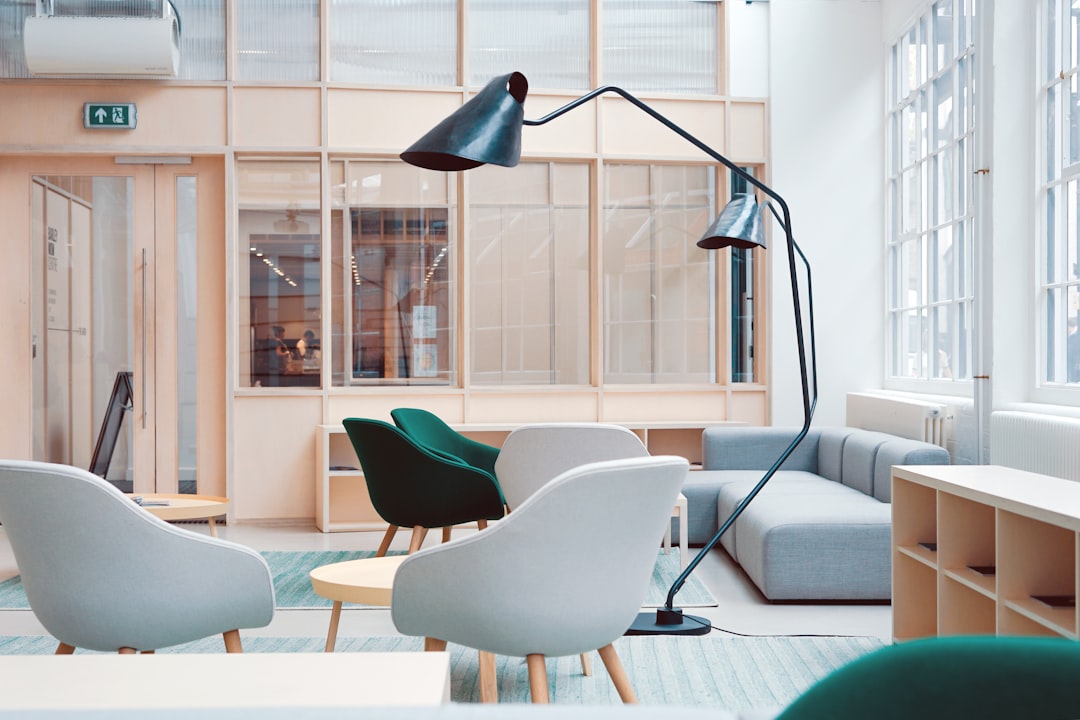Did you know a well-designed home can increase its value by up to 10%? A beautiful home not only improves our life but also our mood and productivity. At the core of every stunning home is a thoughtful interior design that shows the homeowner’s personality and style.
We’ll help you transform your home with amazing home decor ideas and modern interior design principles. We’ll cover everything from the basics to picking the right furniture and decor. Our aim is to give you the knowledge and inspiration to make your dream space a reality.
Key Takeaways
- Understand the basics of interior design
- Discover modern interior design principles
- Learn how to choose the perfect furniture and decor
- Create a functional and beautiful living space
- Boost your home’s value with thoughtful design
Understanding the Basics of Interior Designs
To make your living space better, knowing the basics of interior design is key. A well-designed home is more than looks. It’s about making a space that’s both useful and cozy.
What is Interior Design?
Interior design is about making the inside of a building better. It aims to make a space healthier and more beautiful for those who use it. It’s about knowing what people need and want, and using design principles to meet those needs.
Designers use things like lighting, color, furniture, and textures to make spaces look good and work well. Keeping up with interior design trends helps designers come up with new ways to improve our lives.
Importance of Good Design
Good interior design can really change our daily lives. It can make us feel better, work better, and live better. A well-designed space can also make your home more valuable, which is great if you plan to sell it.
Design isn’t just about how something looks. It’s also about making a space that works well for its users. For example, a well-designed kitchen makes cooking and hosting easier and more fun.
Elements of Interior Design
The elements of interior design are the basics used to make a space work and look good. These include:
| Element | Description |
|---|---|
| Line | Lines help create a sense of flow and continuity in a space. |
| Shape | Shapes add interest and help balance a space. |
| Color | Colors can stir emotions and set a mood. |
| Texture | Textures add depth and feel to a space. |
| Pattern | Patterns add interest and energy to a space. |
| Light | Lighting sets the mood, highlights features, and improves function. |
By using these elements, you can create a space that’s not just pretty but also practical and comfortable. This is inspired by the latest interior design inspiration.
Popular Interior Design Styles
The world of interior design is vast, with many styles to choose from. Each style has its own unique features. Knowing these can help you pick the right one for your home.
Contemporary Design
Contemporary design focuses on clean lines and minimal decoration. It also values functionality. This style often includes luxury home interiors elements, like high-end materials and the latest technology.
“Contemporary design is all about simplicity and elegance,” says a top interior designer. “It aims to create a space that feels open, airy, and free from clutter.”
Minimalist Design
Minimalist design goes further than contemporary, focusing on simplicity and less clutter. It’s perfect for those who like a clean, uncluttered home.
- Neutral color palettes
- Simple, functional furniture
- Minimal decorative elements
Rustic Design
Rustic design celebrates natural materials like wood, stone, and brick. It creates a warm, inviting atmosphere, ideal for cozy homes.
As Country Living magazine notes, “Rustic design brings the outdoors in, using natural materials for a warm, welcoming space.”
Art Deco Design
Art Deco is a glamorous style from the 1920s. It’s known for bold geometric patterns, metallic materials, and ornate decoration. This style adds luxury and sophistication to any room.
Key features of Art Deco design include:
- Geometric patterns and shapes
- Metallic accents like gold and silver
- Bold, contrasting colors
By understanding these popular interior design styles, you can choose the one that best reflects your personality and meets your needs. This way, you can create a beautiful and functional living space.
Choosing the Right Color Palette
The right color palette can change your living space. It shows your personality and style. Choosing the perfect colors is key in interior decorating tips. The colors you pick can change how you feel at home.
Understanding Color Psychology
Colors can make us feel certain ways and set moods. Color psychology studies how colors affect us. For example, blue makes us calm, while red energizes us.
Everyone reacts differently to colors. But, there are basic rules to help pick colors that make your space better.
Tips for Selecting Colors
Here are some interior decorating tips for picking colors:
- Start with a neutral base: Neutrals like white, beige, or gray are good for any decor.
- Consider the natural light: The light in your space changes how colors look.
- Think about the room’s purpose: Colors should match the room’s use.
- Use the 60-30-10 rule: 60% of the room is one color, 30% another, and 10% an accent.
Popular Color Combinations
The best interior designers use well-known color combos. These make spaces look good and feel right. Some favorites are:
| Color Combination | Description |
|---|---|
| Monochromatic | Using different shades of the same color for a unified look. |
| Complementary | Pairing colors that are opposite each other on the color wheel for contrast. |
| Analogous | Choosing colors next to each other on the color wheel for harmony. |
By knowing color psychology, following color tips, and trying popular combos, you can pick colors that show your style. They also make your home look and feel better.
Furniture Selection for Your Space
The right furniture can make your space stand out. It’s important to choose pieces that are both useful and look good. This helps create a welcoming and balanced home.
Types of Furniture Styles
Furniture styles vary, each with its own look. Some popular ones are:
- Modern: Known for simple lines, little decoration, and focus on use.
- Traditional: Offers classic looks, detailed designs, and a cozy feel.
- Mid-Century Modern: Mixes modern simplicity with shapes found in nature.
Knowing these styles helps you pick furniture that matches your design goals.
Importance of Scale and Proportion
It’s key to choose furniture that fits well with your room and other items. Scale and proportion are crucial for a balanced look.
- Measure your room and furniture to ensure a good fit.
- Think about how furniture sizes compare to your room’s size.
- Pair big pieces with smaller ones for a balanced look.
Mixing and Matching Pieces
Mixing different furniture styles can make your space more interesting. Here are some tips:
- Use a common color or material to tie different pieces together.
- Use neutral items to balance out bold styles.
- Try different textures and patterns to add depth.
By carefully choosing and arranging your furniture, you can create a beautiful and functional space. It will show off your personal style and design inspiration.
Effective Use of Space
The way we use space in our homes greatly affects our quality of life. By making our living areas more efficient, we can enjoy a more comfortable home. This makes our living space more enjoyable.
Open Concept vs. Traditional Layouts
Choosing between an open concept or a traditional layout is a big decision in interior design. Open concept layouts are popular for making spaces feel bigger and encouraging socializing. On the other hand, traditional layouts provide private areas and better organization.
What you choose depends on your lifestyle and home. Open concept layouts are great for small homes to feel larger. Traditional layouts are better for bigger homes to separate areas.
Multi-Functional Spaces
Creating multi-functional spaces is a smart way to use your home better. This means using a room for more than one thing or picking furniture that does more than one job. For example, a storage ottoman can be a seat and a place to store things, keeping your space tidy.
When designing these spaces, think about how you live. This way, you can make areas that are both useful and look good, following the latest interior design trends.
Smart Storage Solutions
Good storage is key to a clean and organized home. Smart storage solutions help keep things tidy and use space well. This includes shelves, under-bed storage, and hidden spots in furniture.
When picking storage, think about what each room needs. In the kitchen, drawer dividers can organize utensils. In the bedroom, under-bed storage can hold out-of-season clothes, following useful home decor ideas.
Lighting Design Essentials
Lighting is crucial in interior design, setting the mood and feel of a room. It can make a space look better and feel more welcoming. We’ll look at different lighting types, how to set the mood, and common mistakes to avoid.
Types of Lighting
There are three main types of lighting: ambient, task, and accent. Ambient lighting lights up the whole room. Task lighting helps with specific tasks like reading. Accent lighting highlights certain areas or features. Knowing these can help you create a rich, layered lighting effect.
- Ambient Lighting: General illumination
- Task Lighting: Focused lighting for tasks
- Accent Lighting: Highlights specific areas or features
Creating Ambiance with Lighting
Lighting can change a room’s feel. Warm white lighting makes a space cozy, while cool white lighting energizes it. Using dimmable lighting lets you adjust the mood. For more ideas, check out cozynestplans.com for living room designs.
| Lighting Type | Ambiance Created |
|---|---|
| Warm White | Cozy, Relaxing |
| Cool White | Energizing, Modern |
Common Lighting Mistakes to Avoid
Not using a layered lighting approach can make a room feel flat. Also, ignoring the color temperature of light bulbs can affect the mood. For more on lighting, see decorious.com.
Understanding lighting design is key to creating a beautiful and inviting space. Whether you’re looking for interior design inspiration or a contemporary interior design look, good lighting is essential.
Textiles and Fabrics in Interior Design
In luxury home interiors, the right textiles can make a big difference. They add texture, color, comfort, and depth to a room. This makes the space stand out.
Choosing the Right Fabrics
Choosing the right fabrics involves several factors. You need to think about durability, maintenance, and how they look. For example, linen is great for its breathability and natural look. On the other hand, velvet adds a touch of luxury.
It’s important to consider how you’ll use the room and how comfortable you want it to be. This helps you pick the best fabrics.
Textiles for Different Spaces
Different rooms need different textiles. For example, living rooms need durable fabrics that can handle a lot of use. Bedrooms, on the other hand, are better with softer, more comfortable fabrics.
Knowing what each room is for helps you choose the right fabrics. This makes your home more comfortable and functional.
Mixing Patterns Effectively
Mixing patterns can make a room more interesting. But, it’s important to do it thoughtfully. Start with a main pattern and add smaller patterns to complement it.
Using different textures and patterns can make your room look richer and more layered. This enhances the look of your luxury home.
To mix patterns well, choose a color palette that ties everything together. This creates a cohesive look that makes the room feel complete. For more interior decorating tips, see how different patterns and textures work together.
Personalizing Your Interiors
To make your home truly yours, adding personal touches is key. Working with the best interior designers can help. They can make your space reflect your personality and style.
Adding Personal Touches
Personal touches turn a house into a home. These can include family photos, heirlooms, or personal achievements. The goal is to balance personal expression with your home’s overall look.
A vintage collection can add character to a room. A piece of artwork can spark conversations. It’s about choosing pieces that speak to you and fitting them into your modern interior design.
Incorporating Art and Accessories
Art and accessories are crucial for personalizing your space. They add color, texture, and depth. When picking art and accessories, think about your home’s style and theme.
A modern living room might look great with abstract art or sleek sculptures. A traditional setting might suit classical pieces. The aim is to enhance your space without overwhelming it.
Importance of Cultural Influences
Cultural influences can deeply impact your home’s design. Adding elements that reflect your cultural heritage or travels can make your space unique. This could be through traditional patterns, colors, or decorative items that tell a story.
By embracing cultural influences, you personalize your space and connect to your roots or experiences. This makes your home feel more meaningful and authentic.
Outdoor Spaces and Interior Design
Making indoor and outdoor spaces blend smoothly is key in modern home decor. Our outdoor areas are now a big part of our living space. This change makes our homes more open and welcoming.
Seamless Indoor-Outdoor Flow
To link indoor and outdoor spaces well, use the same flooring or colors. This makes the transition smooth and the spaces feel connected. For ideas, check out homes that mix both spaces, like those in this article.

Designing Functional Outdoor Areas
Outdoor spaces need to be both beautiful and useful. Think about how you’ll use the area. Will it be for eating, relaxing, or both? Multi-functional furniture is a smart choice, offering both comfort and versatility. For instance, a storage ottoman can be a seat and a place to store outdoor items.
Adding outdoor kitchens or fire pits can also make your space more inviting. They add to the area’s function and charm, perfect for relaxing and having fun.
Popular Outdoor Furniture Options
The furniture you choose greatly affects your outdoor space’s look and feel. Durable materials like wicker, recycled plastic, and metal are top picks. They stand up to weather. Pick furniture that matches your home’s style and the landscape around it for a unified look.
- Wicker furniture for a natural, rustic look
- Recycled plastic furniture for a modern, eco-friendly aesthetic
- Metal furniture for durability and a sleek, contemporary style
Sustainability in Interior Designs
Today, we focus more on making our homes and workspaces green. This means using designs that are good for the planet and our health. It’s all about making spaces that look great and are also eco-friendly.
Eco-Friendly Materials
Choosing the right materials is key in green design. Eco-friendly materials are those that don’t harm the environment. Think reclaimed wood, bamboo, and paints that don’t release harmful fumes. These choices help make our homes healthier and better for the planet.
Sustainable Design Practices
Green design is about more than just picking the right materials. It’s about making spaces that use less energy and waste less. This means using natural light, energy-saving gadgets, and recycling in our designs. These steps help lessen our designs’ impact on the environment.
Benefits of Green Design
Green design has many perks, like saving energy and improving air quality. Green design also makes spaces better for our health and work. Plus, it can even make our homes more valuable and help our planet.
| Benefits | Description | Impact |
|---|---|---|
| Energy Efficiency | Reduced energy consumption through efficient systems and design. | Lower utility bills and reduced carbon footprint. |
| Indoor Air Quality | Improved air quality through the use of low-VOC materials and better ventilation. | Healthier living and working environments. |
| Sustainability | Use of sustainable materials and practices. | Reduced environmental impact and promotion of eco-friendly living. |
By adding green elements to our designs, we make spaces that are modern, inspiring, and kind to the earth. This isn’t just a trend; it’s a way to build a greener future for our homes and offices.
Common Interior Design Mistakes to Avoid
It’s easy to make mistakes when designing your space, even with the best intentions. Knowing common interior design mistakes helps you create a beautiful and functional space. We’ll look at some common errors to avoid, helping you achieve your desired interior design.
Navigating Space Effectively
Overcrowding can make a room feel cramped and cluttered. To avoid this, choose furniture and decor that fit your space well. This creates a more harmonious and inviting atmosphere. For more tips, consider consulting with the best interior designers for personalized guidance.
The Importance of Proper Scaling
Ignoring scale and proportion can make a room feel disjointed. Make sure your furniture is proportional to the room and other pieces. This creates a balanced and visually appealing space.
Lighting Considerations
Not enough lighting can negatively impact your space. Proper lighting enhances ambiance and functionality. Consider layering different light sources for the desired effect. Avoiding these mistakes helps you create a space that’s both beautiful and functional, reflecting your personal style.



